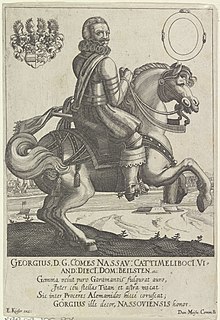George, Count of Nassau-Dillenburg | |
|---|---|
 | |
| Born | 1 September 1562 |
| Died | 9 August 1623 (aged 60) Dillenburg |
| Noble family | House of Nassau |
| Spouse(s) | Anna Amalia of Nassau-Saarbrücken Amalia of Sayn-Wittgenstein |
| Father | John VI, Count of Nassau-Dillenburg |
| Mother | Elisabeth of Leuchtenberg |
Count George of Nassau-Beilstein, later also Count of Nassau-Dillenburg, (1 September 1562 – 9 August 1623 in Dillenburg) was the third son of Count John VI "the Elder" of Nassau-Dillenburg (1536–1606) from his first marriage with Landgravine Elisabeth of Leuchtenberg.
In 1576, he studied at the University of Heidelberg. In 1578, he went to the Netherlands, to serve in the army, under Count of Günther XLI of Schwarzburg-Arnstadt. While in the Netherlands, he tried to be elected Bishop of Utrecht, but failed. From 1580, he attended the court of Margrave George Frederick of Brandenburg-Ansbach-Kulmbach.
In 1604, he purchased his first territory, the district and city of Driedorf from his father. After his father died in 1606, George and his brothers decided to divide Nassau-Dillenburg. When this division was implemented in 1607, William Louis received Nassau-Dillenburg; John VII received Nassau-Siegen; Ernst Casimir received Nassau-Diez; John Louis received Nassau-Hadamar and George received Nassau-Beilstein, which included the Lordships of Westerwald, Burbach and Hickengrund. In 1611, he purchased the Nassau share of the district of Wehrheim, which Nassau shared with Trier, from his brother John VII.
Until 1612, George resided in Dillenburg, as regent for his absent brother William Louis, who was in Holland. After his brother returned, George moved into Beilstein Castle, in his own territory.
In 1618, George reached an agreement with his brother John VII, in which John ceded to George the right to inherit Dillenburg if William Louis were to die childless. This came to happen in 1620. So George moved back to Dillenburg and became the founder of the younger Nassau-Dillenburg line. Nassau-Beilstein was divided, with George keeping Burbach and Hickengrund.
He ruled his territory well; like his brothers he issued court regulations, administrative and law enforcement regulations.
George died in Dillenburg in 1623.